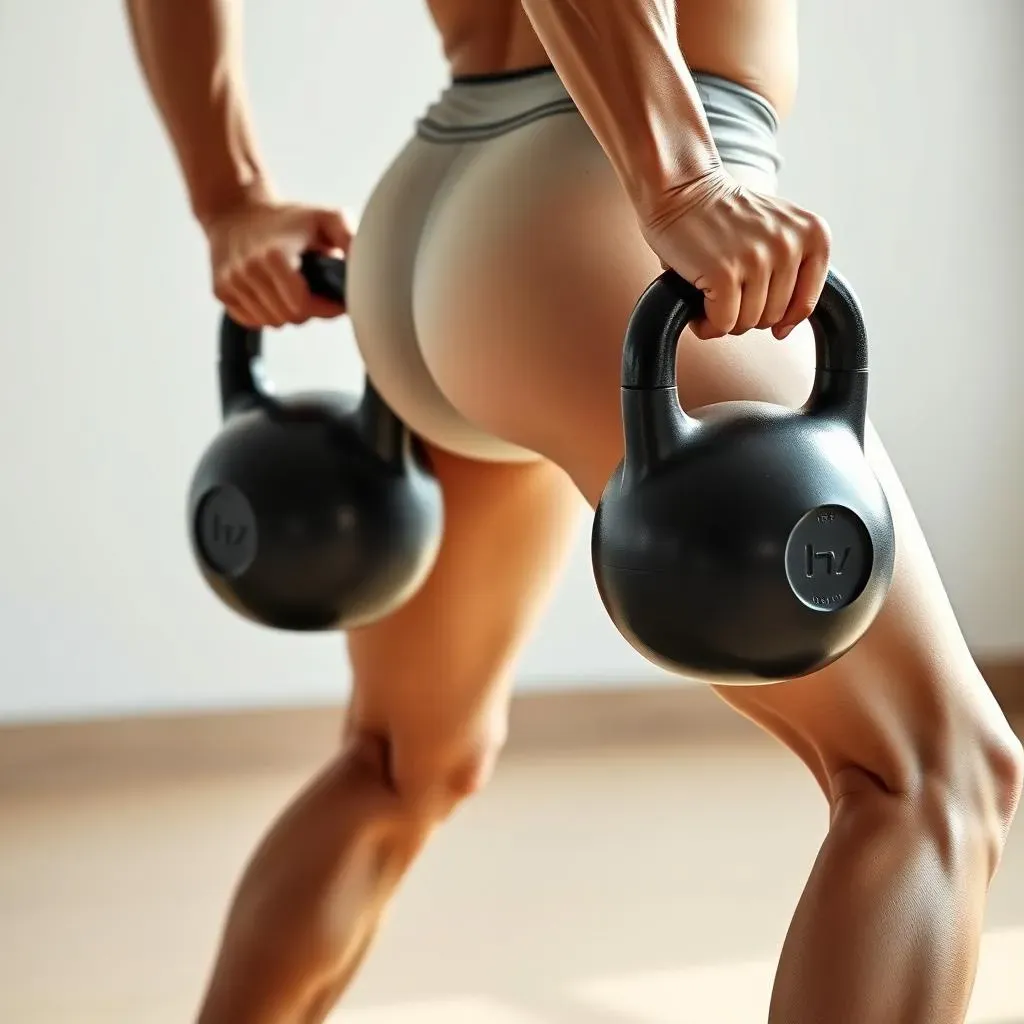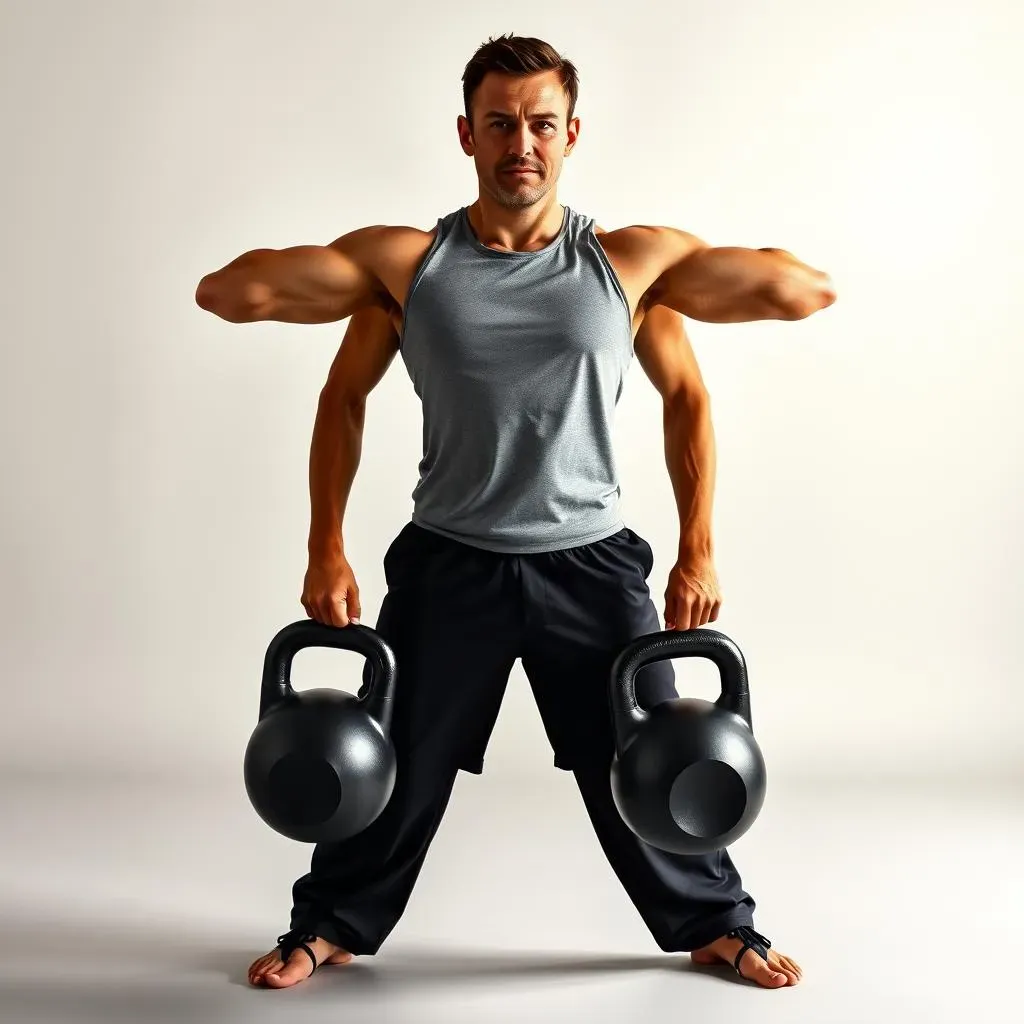Table of Contents
Ever feel like one kettlebell isn't quite cutting it? You're not alone. The standard kettlebell swing is great, but if you're looking to seriously amp up your strength and conditioning, it’s time to meet its beefier cousin: the 2 kettlebell swing. This isn't just about adding more weight; it's about unlocking a whole new level of power, engaging more muscles, and pushing your body in ways you might not have thought possible. This article will guide you through the ins and outs of this powerful exercise. We'll explore why swinging two kettlebells is a game-changer, break down the correct technique to keep you safe and effective, introduce variations to spice up your training, and show you how to smoothly integrate this move into your workout routine. So, get ready to double your gains and discover the power of the 2 kettlebell swing!
Why Two Kettlebells? The Benefits of the 2 Kettlebell Swing

Why Two Kettlebells? The Benefits of the 2 Kettlebell Swing
so you're swinging one kettlebell, feeling pretty good, right? Now, picture this: two kettlebells, double the challenge, double the fun. It's not just about showing off; adding that second kettlebell cranks up the intensity in a bunch of cool ways. For starters, you're gonna feel your core working overtime, trying to keep everything stable. Imagine a boat with two engines – it needs to be extra steady to handle all that power. That's your body when you're doing 2 kettlebell swings. Plus, you're hitting those glutes and hamstrings even harder, which is awesome for building explosive power. This isn't just some fancy trick; it’s a serious upgrade for your strength and conditioning.
And here's a thought: ever notice how we tend to favor one side of our body? Maybe you're a righty who always leads with that arm. Well, swinging two kettlebells forces both sides to work equally hard. No more slacking for your non-dominant side. This helps to iron out any strength imbalances, which is great for preventing injuries down the road. Think of it like tuning a musical instrument – you want all the strings to be in harmony, right? It’s the same with your body. Double the bells, double the balance, double the benefit. It's a total game changer, and once you get the hang of it, you'll wonder why you ever did it with just one.
Benefit | Why It Matters |
|---|---|
Increased Core Activation | Greater stability and power transfer |
Enhanced Glute and Hamstring Engagement | More explosive power and stronger posterior chain |
Reduced Strength Imbalances | Better overall balance and injury prevention |
Improved Grip Strength | Stronger grip which helps in other exercises |
Setting Up for Success: Proper Form for the 2 Kettlebell Swing

Setting Up for Success: Proper Form for the 2 Kettlebell Swing
The Stance: Your Foundation
Alright, let's talk stance. It's not just about standing there; it's about setting up a solid base for those 2 kettlebell swings. Picture yourself like a sturdy tree, roots firmly planted. You'll want your feet a bit wider than shoulder-width apart. This gives you stability and room to swing those bells without your knees getting in the way. Imagine you're about to do a broad jump – that's the kind of stance you're aiming for. It should feel balanced and strong, not like you're teetering on the edge of a cliff. Keep your toes pointed slightly outward, which helps activate those glutes. This isn't just a detail; it's the secret sauce for a powerful swing.
Now, before you even think about picking up the kettlebells, practice that stance. Feel how the weight is distributed through your feet. Are you leaning too far forward or back? Adjust until you feel grounded and ready. It's like building a house – you wouldn't skip the foundation, right? Same goes for your swing. A solid stance is your anchor for a powerful and safe movement. Take a few seconds to get it right each time, and you'll notice a huge difference in your swing quality.
The Grip: Holding On Tight
Next up, the grip. When you grab those kettlebells, don't just clutch them for dear life. You want a firm grip, but not so tight that you're tensing up your shoulders. Think of it like holding a hammer – secure, but relaxed. Your knuckles should be pointing forward, and the kettlebells should be sitting comfortably in your hands, not digging into your palms. If they are, you might need to adjust your grip or consider using chalk. You're aiming for a connection with the kettlebells, not a wrestling match.
Grip strength is crucial here, so don't ignore it. If you're struggling to hold on, it might be a sign that you need to work on your grip. You can do this by adding exercises like farmer's carries or dead hangs to your routine. Remember, a good grip is not just about holding on; it's about controlling the kettlebells throughout the entire swing. It’s the difference between a smooth ride and a bumpy one. Practice getting that grip right each time, and you'll be swinging like a pro in no time.
Grip Component | Why It's Important |
|---|---|
Firm but Relaxed | Prevents unnecessary tension and allows for better movement |
Knuckles Forward | Ensures proper alignment and power transfer |
Kettlebells in Hands, Not Palms | Comfortable grip and better control |
The Hike and Swing: The Movement
Now, the moment we've all been waiting for: the actual swing. It all starts with the hike. Think of it like a pendulum. You're going to hinge at your hips, pushing your butt back and letting the kettlebells swing back between your legs. It’s like you're hiking a football – that same motion of getting the weights behind you. Keep your back straight, and don't round your shoulders. This is crucial for preventing injuries. The hike is not just the start; it's the loading phase for the swing.
Then, the snap. It's all about exploding your hips forward, using your glutes and hamstrings to propel the kettlebells up. Your arms are just along for the ride; they're not lifting the weights. Think about it like a jump – you're not using your arms to jump high. It's all in the legs. The kettlebells should swing up to about chest height, and then you're back to the hike. It’s a continuous loop. Remember, the 2 kettlebell swing is about power, not just lifting the weights. Get that hip snap right, and you'll be amazed at how much power you can generate. Practice this step-by-step, and it will become a natural, fluid motion.
2 Kettlebell Swing Variations: Adding Challenge and Variety

2 Kettlebell Swing Variations: Adding Challenge and Variety
so you've nailed the basic 2 kettlebell swing, feeling like a total boss, right? But here's the deal: variety is the spice of life, and it's also key to keeping your workouts effective and engaging. Think of it like this, you wouldn't eat the same meal every day, would you? Well, your body gets bored too. That's where 2 kettlebell swing variations come in. It's not about making things harder just for the sake of it; it's about targeting different muscles, improving your coordination, and keeping your body guessing. So, let's dive into some cool ways to mix things up and take your swing game to the next level.
First up, we have the deadstop swing. This variation is all about control and explosive power. Instead of swinging straight into the next rep, you bring the kettlebells to a complete stop on the floor between each swing. This forces you to reset your body, engage your core, and generate power from a dead stop. It’s like hitting the reset button on each rep, making sure each swing is intentional and powerful. Then there's the hand-to-hand swing. This one adds a coordination challenge. As the kettlebells swing up, you pass one bell to the other hand at the top of the swing, alternating hands each rep. It's like a juggling act, but with weights. This not only improves your coordination but also works different muscles in your upper body. These variations are not just fancy tricks; they're tools to help you become a more well-rounded athlete.
Variation | Focus | Benefits |
|---|---|---|
Deadstop Swing | Control and Power | Improved core engagement and explosive strength |
Hand-to-Hand Swing | Coordination and Stability | Enhanced coordination and upper body engagement |
Integrating the 2 Kettlebell Swing Into Your Workout Routine

Integrating the 2 Kettlebell Swing Into Your Workout Routine
Finding the Right Fit: Where to Place the 2 Kettlebell Swing
Alright, so you're ready to bring the 2 kettlebell swing into your training, but where exactly does it fit? It's not like you can just throw it in anywhere and expect magic to happen. Think of your workout like a well-balanced meal; each exercise has its place. The 2 kettlebell swing is a fantastic full-body movement, making it versatile enough to fit in various parts of your routine. You could use it as a power-building exercise at the start of your workout, when you're fresh and ready to go. Or, it can be a killer finisher, burning out your muscles and pushing your conditioning to the limit. It's all about listening to your body and finding what works best for you. It is not just a random exercise; it’s a tool in your fitness arsenal.
For example, if you're focusing on strength training, you might do your heavy lifts first and then use the 2 kettlebell swing as a supplementary exercise. If you're doing a conditioning workout, then you might use it in a circuit format, alternating it with other exercises like push-ups, squats, or burpees. The key is to think about the overall goal of your workout. Are you trying to build strength, improve your endurance, or both? It’s like choosing the right ingredient for a recipe. You wouldn't put sugar in a savory dish, right? Same goes for your workout. Place your exercises strategically to maximize their benefits.
Programming for Success: Reps, Sets, and Rest
Now, let's talk about the nitty-gritty: reps, sets, and rest. There's no one-size-fits-all answer here; it really depends on your goals and experience level. If you're new to the 2 kettlebell swing, it's best to start with lower reps and sets, focusing on form over intensity. Something like 3 sets of 8-10 reps is a great starting point. As you get more comfortable, you can gradually increase the reps, sets, or the weight of the kettlebells. It’s like learning a new skill; you start slow and build up your proficiency. Don't rush it, and don't try to do too much too soon.
The rest period is just as crucial. It's not about how hard you go, but about how well you recover. If you're doing the 2 kettlebell swing for strength, you'll want longer rest periods, maybe around 60-90 seconds between sets. If you're using it for conditioning, you can shorten the rest periods to 30-45 seconds. It all comes down to what you're trying to achieve. Think of rest as the fuel for your next set. You need time to recover so that you can give it your all on the next round. It’s not laziness; it's part of the process. So, listen to your body, and adjust your programming accordingly.
Goal | Reps | Sets | Rest |
|---|---|---|---|
Strength | 8-10 | 3-5 | 60-90 seconds |
Conditioning | 12-15 | 3-4 | 30-45 seconds |
Wrapping Up: Unleash Your Power with the 2 Kettlebell Swing
The 2 kettlebell swing isn't just a tougher version of the single-bell swing; it's a transformative exercise that can seriously boost your strength, power, and overall fitness. By mastering the proper form and progressively challenging yourself with variations, you'll not only see physical improvements but also feel a new level of athleticism. So, grab those two kettlebells, get swinging, and prepare to take your training to the next level. It's time to experience the difference double the bells can make.